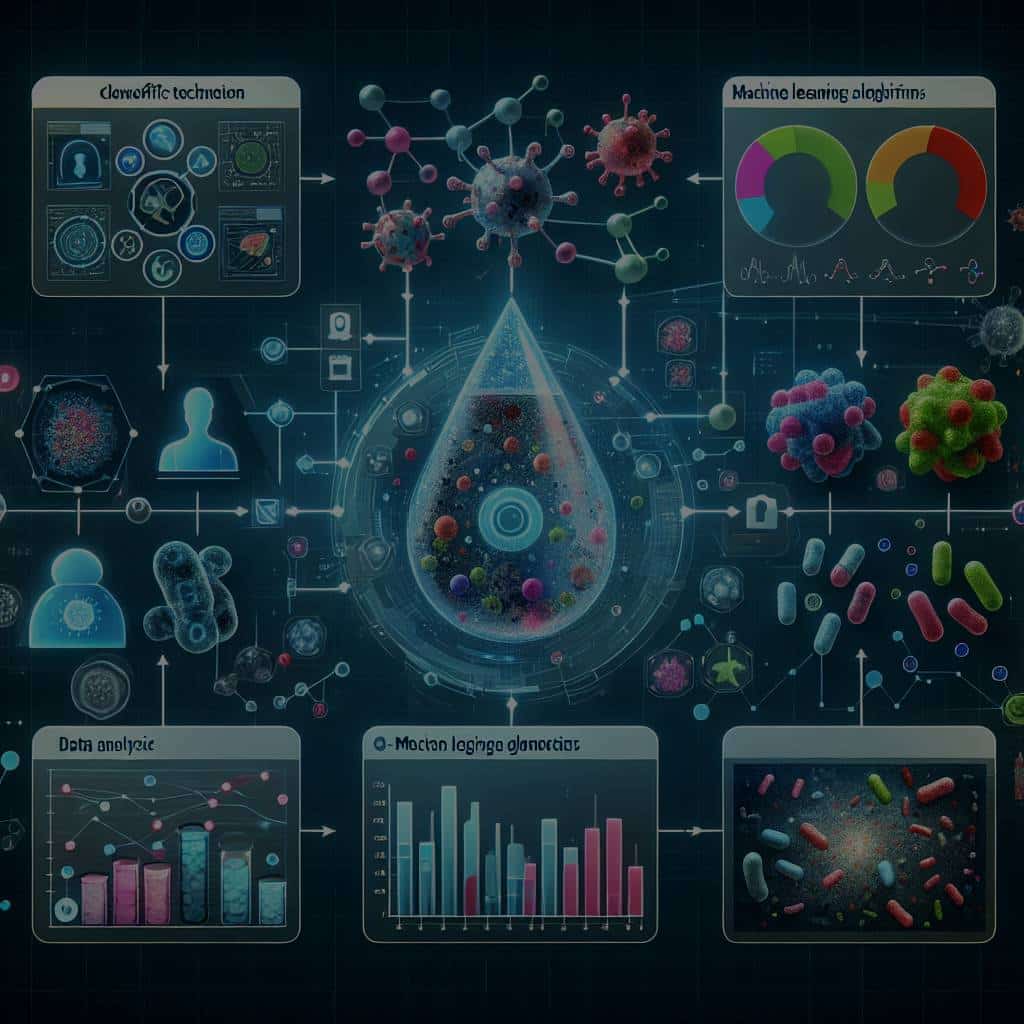How Are Machine Learning Algorithms Transforming Pathogen Detection in Water Supplies?

Every day, you drink, cook, and bathe with water that has been treated and tested for safety. But how often do you consider the complexities behind ensuring that your water is pathogen-free? In recent years, machine learning has emerged as a significant tool in improving the accuracy and efficiency of pathogen detection in water supplies. This article will delve into how this application of advanced technology is revolutionizing the way we ensure water quality.
Scholarly Research on Machine Learning and Water Quality Analysis
Traditionally, water quality analysis has relied on periodic sampling and laboratory testing. While these methods have served us well for some time, they are not without their limitations. They can be time-consuming, costly, and lack the ability to provide real-time data.
Also to read : What’s the Role of AI in Adaptive Traffic Signal Timing for Urban Efficiency?
Today, the digital world is awash with scholarly articles that explore the innovative ways machine learning algorithms are being used to address these limitations. These articles, accessible via platforms like Google Scholar, Crossref, and PubMed, delve into the potential of these algorithms for water quality analysis.
Machine learning, a type of artificial intelligence, involves teaching a computer system to make accurate predictions or decisions without being explicitly programmed to perform the task. In the context of water quality analysis, these algorithms can analyze vast amounts of data to predict the presence of pathogens in water supplies.
In the same genre : How Can AI Personalize Audio Experiences to Enhance Learning and Concentration?
Improved Accuracy and Efficiency in Pathogen Detection
One of the most significant advantages of machine learning in pathogen detection in water supplies is its potential for increased accuracy and efficiency. By continually learning from data, these algorithms can make more accurate predictions over time.
For instance, let’s say a machine learning model is trained on data of water samples, including variables like temperature, pH, turbidity, and past pathogen occurrences. Over time, as the model is exposed to more samples, it can improve its accuracy in predicting the presence of pathogens based on these variables.
In contrast to traditional methods, where water samples would need to be physically collected and sent to a lab for testing—a process that could take days—machine learning algorithms can potentially provide near real-time insights.
Application of Machine Learning in Prediction of Waterborne Pathogens
Predicting the presence of waterborne pathogens is a critical aspect of water quality management. Early detection of these pathogens can help prevent waterborne diseases and ensure the prompt treatment of water supplies.
Machine learning algorithms can be used to predict the likelihood of pathogen presence in water supplies based on various environmental and water quality parameters. For instance, machine learning models may analyze data such as temperature, rainfall, and water turbidity to predict the likelihood of harmful bacterial presence.
Recent studies published on platforms like PubMed have demonstrated the successful application of machine learning in predicting the likelihood of E.coli and other bacteria presence in water sources. This shows the potential of this technology in enhancing pathogen detection and overall water quality management.
Real-world Implementation of Machine Learning in Water Quality Analysis
While the potential benefits of machine learning in pathogen detection are clear, how are these concepts being applied in the real world?
Firstly, machine learning models require substantial amounts of data to learn and improve. Various sources of data, like historical water quality records, environmental data, and real-time sensor data, can be used to train these models.
Other critical considerations for the successful implementation of machine learning in water quality analysis include the selection of appropriate machine learning models, data pre-processing, and the validation of model predictions.
It’s worth noting that while machine learning is a powerful tool, it is not a standalone solution for water quality management. Instead, it should be viewed as a complement to traditional water testing methods, providing additional insights and efficiencies that can enhance overall water quality management.
Challenges and Future Prospects of Machine Learning in Water Quality Analysis
Despite the significant potential of machine learning in enhancing pathogen detection in water supplies, several challenges need to be addressed.
For one, machine learning models often require substantial amounts of high-quality data to function effectively. However, in many regions, such data may not be readily available. Furthermore, while machine learning algorithms can make accurate predictions based on the data they are trained on, their ability to generalize these predictions to new scenarios or data sets can be limited.
Nonetheless, as technologies continue to advance, and as more high-quality data becomes available, the role of machine learning in water quality analysis is expected to grow. In the future, we can anticipate a world where machine learning algorithms complement traditional water testing methods, providing real-time insights, predicting potential threats, and ensuring the safety of our water supplies.
Remember, water is a fundamental human right. Ensuring its quality is not just a scientific challenge but a societal one too. The incorporation of machine learning in our battle against waterborne pathogens signifies a promising step towards securing this right for everyone.
Machine Learning Techniques in Water Quality Analysis
Machine learning techniques such as neural networks, support vector machines, and time series analysis have shown immense potential in advancing water quality analysis. These techniques are capable of handling the complexity and variability of water quality data, making them quite effective for this task.
In the case of neural networks, they model the data by mimicking the way neurons in the human brain process information. This technique is particularly effective in making predictions based on non-linear patterns in the data, which traditional statistical methods may fail to capture.
Support vector machines, on the other hand, are incredibly efficient in dealing with high-dimensional data. They work by finding the optimal hyperplane in a high-dimensional space that separates different classes of data. In the context of water quality analysis, a support vector machine can be used to classify water samples based on their likelihood of being contaminated with pathogens.
Time series analysis is another prominent technique in machine learning, which allows for the prediction of future values based on past data. This technique can be incredibly useful in predicting potential fluctuations in water quality based on historical trends.
All these techniques, with the capacity to unearth hidden patterns and relationships in big data, could be instrumental in improving the detection of pathogens in water supplies.
Combining Machine Learning and Remote Sensing for Enhanced Pathogen Detection
One promising approach that combines machine learning with remote sensing is gaining traction in the field of water quality analysis. Remote sensing involves the use of satellite or aircraft-based sensor technologies to detect and classify objects on the earth, including the detection of changes in water quality.
By combining machine learning and remote sensing, researchers can create more accurate and efficient techniques for pathogen detection in water supplies. The machine learning model can analyze remote sensing data to predict potential pathogen contamination in water bodies.
For example, a machine learning model could analyze remote sensing data on parameters like water temperature, turbidity, and chlorophyll concentration, known to influence pathogen presence. This information can then be used to predict the likelihood of pathogen contamination in different water sources.
By combining these technologies, we step into a new era of water quality management. One where traditional lab-based methods are complemented by advanced, real-time, and data-driven techniques, thereby enhancing our ability to safeguard our precious water resources.
Conclusion
Ensuring the safety of our drinking water is a challenge that continues to confound many parts of the world. Traditional methods of pathogen detection, involving lab-based testing of water samples, have served us well but are fraught with limitations.
Today, machine learning is heralding a new era in water quality analysis. Its ability to analyze vast amounts of data, make accurate predictions, and provide near real-time insights is transforming the way we detect pathogens in water supplies. Its potential is further amplified when combined with other advanced techniques like remote sensing.
The search for better methods of water quality prediction is by no means over. As we continue to advance technologically, machine learning will play an increasingly vital role in this quest. It’s not just about ensuring we have safe water to drink. It’s about creating a future where clean water is a reality for everyone, and machine learning points us in the right direction.
Let’s remember that the success of these advanced techniques hinges on the availability of high-quality data. As such, we must continue to invest in systems that enable the collection, management, and sharing of water quality data.
In the words of Leonardo da Vinci, "Water is the driving force of all nature." As we strive to protect this vital resource, machine learning stands as a promising ally.
